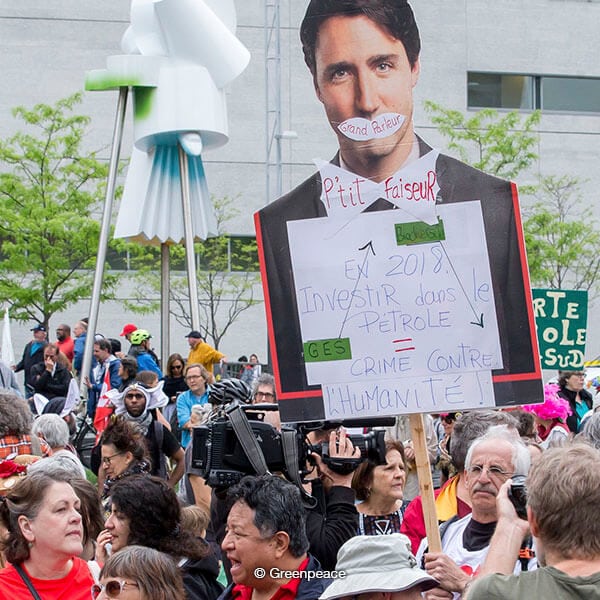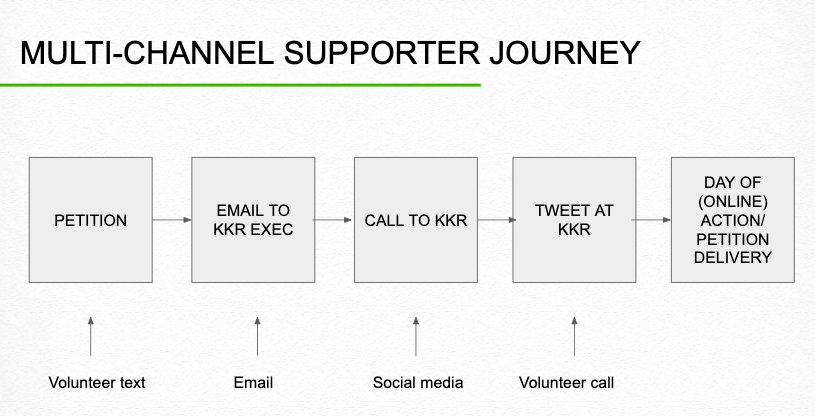
Toolkit: Digital Organizing and Digital Campaigning 101
Intro:
Last night Greenpeace hosted a training on digital organizing and digital campaigning 101. This toolkit will provide everything you need to catch up if you missed the call.
We hope to keep growing and expanding our impact, from calling on Congress to holding corporations responsible for polluting our communities and ecosystems. Our action doesn’t stop at the call though.
Below is everything you need to take action with Greenpeace!
Here’s what we learned:
- We Learned the power of digital organizing and campaigning
- We put collective power on KKR, an American global investment firm that manages multiple alternative asset classes, including energy and infrastructure, with a multi channel approach.
- We connected to other Greenpeace supporters across the country
Get the Slides here.
Watch
You can watch the full training! Make sure to check out the sections below for additional details regarding the training.
The Basics:
What’s digital organizing?
Digital organizing gives us the ability to foster offline relationships en masse by leveraging online platforms and tools like Facebook, Twitter, and Instagram.
- Digital organizing is an organizing tool. At the end of the day, you still need to create personal relationships with people.
- Digital organizing gives you the ability to reinforce offline pushes.
- Digital organizing work is about establishing, maintaining, and amplifying a presence online to organize people to take action.
People have different abilities, schedules, or barriers to overcome, digital organizing is a way of working that allows more people to get involved in campaigns/projects.
What’s digital campaigning?
If organizing is about building our collective muscle, then digital campaigning is about flexing our muscle/power. It’s about a group of people putting pressure on a bad actor or movable campaign target.
Using an array of online channels, digital tools, and storytelling to inspire people to take action and turn the resources they have into the power they need to make the change they want.
Supporter Journey
A supporter journey is a path a supporter may take as the participate in a particular campaign. Supporter journeys are used in designing campaigns to identify different ways to enable supporters to achieve their goal as quickly and easily as possible.

Asking people to take action
Moment of influence (Crisitunity): Using an array of online channels, digital tools, and storytelling to inspire people to turn the resources they have (their voice, vote, etc) into the power they need to make the change they want.
Example:
Crisis: Trump has just approved the disastrous Dakota Access Pipeline. (problem)
Opportunity: The project is financially precarious, and public pressure could force DAPL’s investors to pull out (solution) in the next 3 months (urgency)
Theory of change: If we put enough pressure on DAPL’s investors to do the right thing, we can get their to pull out of the pipeline because they’re concerned about brand damage with their shareholders and the public
Ask: Will you email, tweet at, and call DAPL’s investors and ask them to pull out of the destructive pipeline project?
Remember what’s fundamental
Only the pressure of people power/thousands, ten of thousands, hundreds of thousands. Millions of voices create meaningful, long term wins. So, people organizing together to take action is fundamental.
As an organizer, it’s typically your responsibility to take on a lot of work, but when you have more people helping, the more you can accomplish, the better ideas come along, and more resources accumulate. Two heads are always better than one!!
Take action now:

Tell KKR: Don’t invest in the Coastal GasLink pipeline. Respect Indigenous health now!
The Canadian oil and gas industry is carelessly putting the Wet’suwet’en people in Northern British Columbia, Canada, at great risk of contracting the COVID-19 virus by continuing the construction of TC Energy’s Coastal GasLink pipeline.
As we speak, Coastal GasLink is sending workers and federal police officers onto Wet’suwet’en land without proper consent endangering Indigenous elders, children, community members, and the Coastal GasLink workers themselves. But, like all big infrastructure projects, this pipeline relies on a slew of investors to make it all happen. And, there’s still time to stop the pipeline from being financed.
KKR — a US-based private equity firm with an atrocious record of putting profits over people and the environment — is planning to purchase 65% of the Coastal GasLink pipeline with Alberta Investment Management Corporation (AIMCo) this year, giving TC Energy the $600 million it needs to finance the project.
If we mobilize online together right now, we’ll be able to stop KKR from investing in the Coastal GasLink Pipeline.
Stay in the loop & Join future calls!
Take Action Tuesdays are new, so make sure to stay in the loop.
- Check out our other calls – including next week’s Take Action Tuesday – in our volunteer call calendar!
- Join our Greenpeace Action Calls where we will learn together, take action together, and build community during these difficult times. Sign up here to access our Volunteer Call Calendar and get updates on upcoming opportunities!
- Join our Greenpeace slack to talk with other Greenpeace volunteers, ask questions and be the first to hear about new opportunities to take action.
- Weren’t able to make the call? Check out the slides. Watch the recording.
Thank you for taking action & staying positive,
Supporter Mobilization (SupMob) Team at Greenpeace USA
Got any questions?
If you have any questions or run into any issues, reach out to the Supporter Mobilization Team at [email protected]
